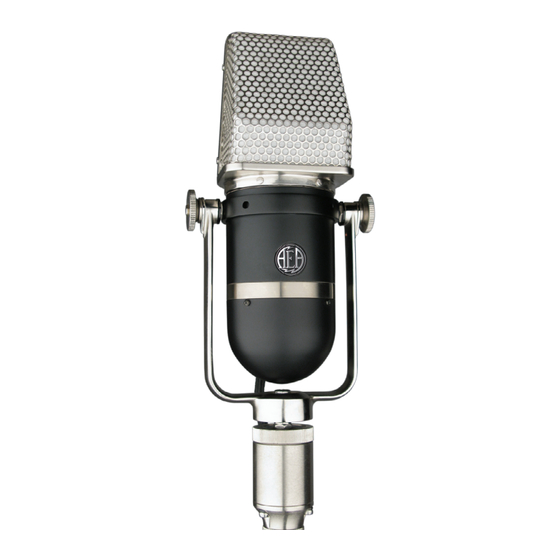
Advertisement
Quick Links
A
udio
1029 N. Allen Ave.
What made the KU3A so special? Based on the smooth long-ribbon sound of RCA's classic model
44BX, the KU3A provided a unidirectional, rather than a bi-polar, response pattern. In contrast to the
RCA 77-D(X), the KU3A had a fixed pattern. Thus, RCA was able to improve the polar response as
a function of frequency by optimizing the shape of the ribbon motor and by fine-tuning the acoustic
design of the microphone. With its wider sweet spot and reduced proximity bass boost, it expanded the
recording engineer's range of placement options making it a standard for location sound, film scoring,
and recording studios around the world.
By the end of the 1960s, condenser (capacitor) microphones had become the new standard throughout
the recording industry, replacing their bulkier and more fragile ribbon ancestors. Nonetheless, ribbon
microphones - both old and new - are highly valued for their sonic characteristics by experienced music
recording engineers and remain in daily use. Because the KU3A is a rare collector's item, few studios
or rental houses own them, so opportunities to work with a good KU3A are limited.
Following our tradition of providing "reincarnations" of the original RCA microphones, AEA is proud
to introduce the new AEA KU4 studio ribbon microphone, featuring new-old-stock (NOS) RCA ribbon
material, parts interchangeable with the original KU3A, and the consistent and reliable performance for
which our microphones have gained a world-wide reputation.
E
ngineering
Associates
Pasadena
CA
91104
Owner's Manual
INTRODUCTION
Unless you have used an original RCA KU3A (also known by its manufactur-
ing number M-10001), the new AEA KU4 is unlike any ribbon microphone
you have ever experienced. This is due, in part, to its unique supercardioid
polar pattern. Designed in the late 1940s to fulfill the uncompromising de-
mands of the Hollywood movie studios, the KU3A was RCA's most expen-
sive ribbon microphone, and many engineers consider it to be the best unidi-
rectional ribbon microphone ever made. Fewer than 600 were manufactured,
and those that remain in existence are highly prized for their sensitivity, their
rich lower midrange, and their surprisingly strong high-frequency presence.
www.ribbonmics.com
Phone: (626) 798-9128
KU4
Fax: (626) 798-2378
Advertisement

Subscribe to Our Youtube Channel
Summary of Contents for AEA KU4
- Page 1 Following our tradition of providing “reincarnations” of the original RCA microphones, AEA is proud to introduce the new AEA KU4 studio ribbon microphone, featuring new-old-stock (NOS) RCA ribbon material, parts interchangeable with the original KU3A, and the consistent and reliable performance for...
- Page 2 QUICK-START GUIDE To maintain the best performance from your new AEA KU4 microphone, take note of these five basic rules: 1) Keep the microphone covered when it is not in use. 2) Always use a sturdy microphone stand or a boom with a counterweight.
- Page 3 HOW IS THE KU4 DIFFERENT FROM OTHER RIBBON MICROPHONES? All ribbon microphones are dynamic pressure-gradient transducers. They respond to the difference in pressure between the front and back of the ribbon. As soundwaves move the ribbon in the magnetic field the ribbon generates a small current directly in response to the velocity of its movement. Thus, it needs no internal electronics.
- Page 4 The AEA KU4 is unlike any other ribbon microphone, because its polar response has been tailored to provide a supercardioid pickup pattern. AEA KU4 Polar Response 330° 30° 300° 60° 270° 90° 200Hz 500Hz 1000Hz 240° 120° 2000Hz 5000Hz 7000Hz 210°...
- Page 5 Since the KU4 is not likely to be used as a boom micro- phone anymore, there is no need for the extreme vibration isolation of those early shock mounts. The AEA cushion mount has been successfully used on the R44 series microphones for many years and is therefore a good match.
- Page 6 Such a setup requires complex and often cumbersome headphone monitor mixes for the musicians. Because the KU4 has a supercardioid pattern, it has nulls at approximately ± 135° from the principal (front) axis. Projected in three dimensions, these nulls produce a “cone of rejection” to the rear of the microphone that can be used effectively to reduce leakage.
- Page 7 RCA-44BX (now in the collection of the Pacific Pioneer Broadcasters in Hollywood) sounds as good today as it did when he recorded his radio broadcasts in the 1940s. A few simple precautions will help you to keep your AEA KU4 working well for life: … Beware the Power Play The first, and perhaps most important rule with ribbon microphones is “Don’t connect them to...
- Page 8 Common 10-lb. round-base microphones stands are just fine if you are working with a Shure SM58. Heavier ribbon microphones, such as the AEA R77, R84, or your new KU4 need sturdy sup- port. Many manufacturers provide heavy, solid-based stands (e.g. the Atlas MS 20 or MS 25) or portable tripod stands with a wide effective diameter.
- Page 9 KU4. Vocals Our experience with the KU4 is that it sounds best on vocals when used at a distance between 6 - 12 inches. However, you may find that positioning the microphone closer or further away from the singer yields better results depending on the voice, the room or the musical style.
-
Page 10: Specifications
Included: Custom storage/shipping case, stand adapter, manual, gray twill zippered bag, and attached 3 meter microphone cable. KU4 weight with cable: 4.7 pounds (2.15 kg) Limited Warranty: KU4 weight with case: 7 pounds (3.2 kg) Three years parts and labor, shipping not included.
















Need help?
Do you have a question about the KU4 and is the answer not in the manual?
Questions and answers